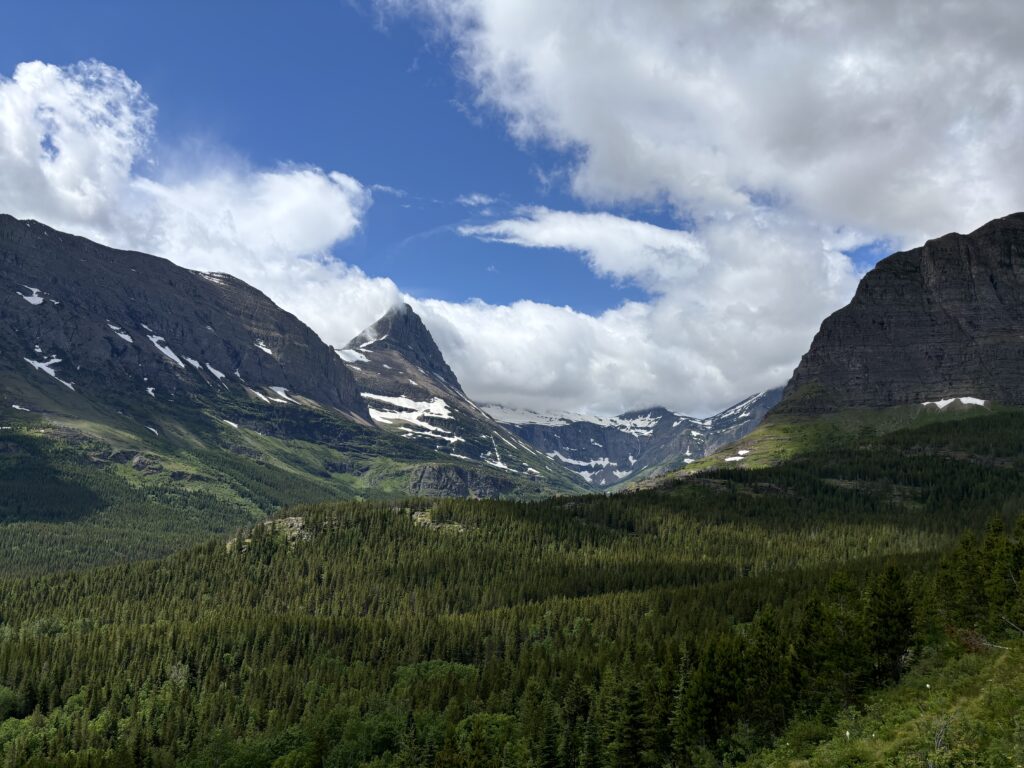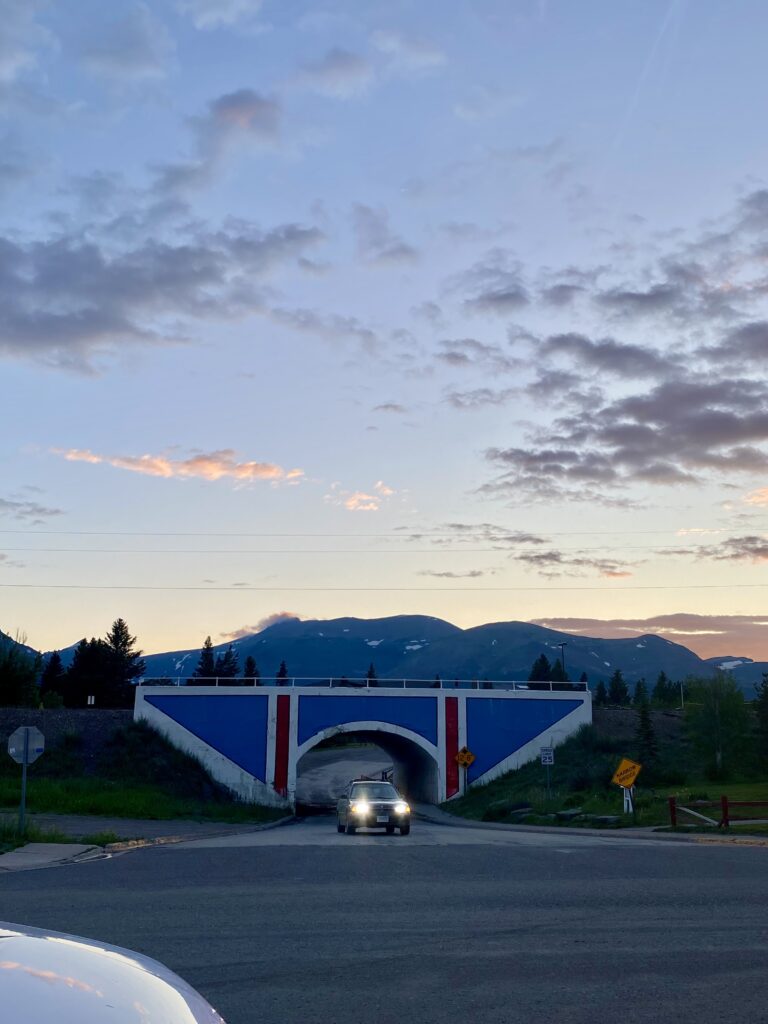The Rocky Mountain Front is a landscape of striking contrasts. To the east, prairie grasses and rolling hills embody wild possibility. To the west, Douglas firs and aspens beckon adventurers to towering snowy peaks and flowing rivers. This region’s meticulously shaped mountains form a historical boundary separating two worlds. To the east lies the Blackfeet Confederacy’s territory, where many live in poverty and continue to feel the effects of settler colonialism. To the west, sheltered by the mountain range, affluent towns with lodges and tourist shops entertain visitors like myself. In the town of Browning, Montana, the Blackfeet Confederacy proudly calls the vast landscape part of their original homeland.

During our journey through Glacier and Browning, we observed and discussed some hard truths and notable successes in the complex relationship between the Blackfeet and Glacier National Park. Our time in Browning brought discomfort as we witnessed the stark reality of life there. I have no intention of preaching or pitying the Blackfeet community. Instead, I aim to share some encounters that any visitor might notice and question in relation to history, Glacier National Park, and U.S. systems. I am grateful to have met many noble, intelligent, and kind Blackfeet individuals who work hard to preserve their culture, build community, and challenge systems of injustice.
Our first full day in Browning involved exchanging goods and restocking supplies. Driving down the main road, I saw dilapidated homes, abandoned shops, and numerous signs for Christian conversion. In the laundromat, a bulletin board displayed several missing Blackfeet women, men, and children, each with descriptions, contact information, last seen dates, and cash rewards for information. I looked up their names online and found nothing—no public news articles or Amber Alerts. This lack of urgency and humanity made me reflect on the minimal Indigenous representation in U.S. news. Later, I learned that the U.S. Congress does not allow the Blackfeet police to handle most murder and kidnapping cases because victims are often taken from the reservation onto federal land. A U.S. federal investigator from Montana, of which there is only one, must be called. I was told by a guest speaker that this interaction rarely happens and often the investigator doesn’t sign off on the papers until the victim is pronounced dead, ultimately closing the case. We do not see the faces of the hundreds of Blackfeet lives lost to rape, kidnapping, murder, and other injustices and hate crimes.

Later, we visited the only grocery store in Browning. I was shocked by the high prices of fresh produce and anything unprocessed. A small bundle of strawberries cost $12, and an 18 oz bag of raw almonds cost $23. At checkout, the cashier warned, “This is going to hurt your wallet,” and she was right. We chatted, and she explained that fresh produce arrives once a week and most people shop at the beginning of the month when paychecks come in. We were shopping on June 30, and our group of hungry hikers bought enough food for the next two weeks. I didn’t feel successful for getting baby carrots; I felt guilty for taking food from people who work hard to live healthy lives. The cashier said, “The food most people can afford is making my people sick.” Later, Chief Bird Dr. Mike Bruised Head echoed this sentiment, saying, “It is not in my peoples’ DNA to consume these fabrications of food. That is why we are seeing a great rise in obesity, diabetes, and cancer.” This issue is critical globally, but especially in areas where affordable food harms long-term health.
Our first experience inside Glacier National Park brought feelings of uncomfortable confusion and bewilderment. We had spent ten days backpacking in the Bob Marshall Wilderness, discussing U.S. land management, conservation biology, migration of keystone species, land use names, and Blackfeet history. Entering Glacier, surrounded by tourists with big cameras and money for gift shops, felt wrong. However, we understood that for many, visiting this place is a significant and memorable life experience. As we hiked popular trails, we contemplated our right to be there, knowing this region’s sacred and historical importance to the Blackfeet culture. We stopped for lunch by a waterfall and discussed our mixed emotions of gratitude and sadness over the brutal history of land theft to create a “natural” tourism simulation. John Grinnell was one of the first to propose Glacier National Park. Over time, treaties were formed, and the Blackfeet lost rights to their native hunting and ceremonial grounds. The only acknowledgment I saw in the area was a laminated land acknowledgment posted near the bathrooms.
In Glacier, we met Alicia and Taos Yellow Owl, Blackfeet tribal members, on the Running Eagle Trail. Alicia is an advocate for preserving Blackfeet culture and language, involved in the local Blackfeet community college, the Blackfeet Confederacy Council, Buffalo restoration projects, and the “Native Speaks” program at Glacier. Taos, her son, spoke about growing up learning his native language at immersion school. Alicia explained that she didn’t grow up speaking Blackfeet due to the trauma and shame from residential schools. Her parents couldn’t speak Blackfeet because their parents experienced the horrors of “Kill the Indian, to save the man.” Alicia wants her children to know and be proud of their culture and language. She and Taos expressed that while systematic shifts in decision-making and Blackfeet history representation in the park are needed, there is still much work to be done.
Our group also had the privilege of meeting elder Chief Bird Dr. Mike Bruised Head. He spent hours sharing wisdom, life stories, and history. He is the first person to earn a Ph.D. written entirely in Blackfeet, focusing on reinstating original Blackfeet names to mountains within traditional territory. As a man in his 80s, he shared his painful experiences in residential school, where he was punished for speaking Blackfeet. Despite his hardships, he remains optimistic and dedicates his life to sharing stories and advocating for the Blackfeet people’s prosperity. This conversation is one I hope never to forget.
These experiences highlight the contrast between visiting a place ignorantly and visiting with the intent to create relations and ask hard questions to uncover the truth. I believe the National Park intentionally developed the west side for large hotels, summer homes, and pristine shopping scenes, with towns like Whitefish as perfect examples. To bridge the gap between the Rocky Mountain boundary, we must humbly sit with those whose life experiences differ from ours, question who has a say at the table, and how they are represented. We need to acknowledge our full history and strive for reconciliation—not just for human justice, but for the plants and animals that call this landscape home. Reflecting on the Rocky Mountain Front, I see everything that is bigger than myself. This landscape offers a beautiful melody of diverse knowledge and history. By taking the time to observe and listen, we may gain the privilege of shared wisdom to promote change.
